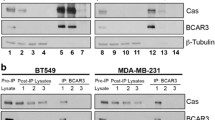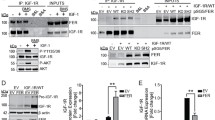Abstract
Reports that the adhesion-associated molecule p130Cas/BCAR1 promotes resistance to tamoxifen suggested that adhesion-mediated signalling may be altered by tamoxifen treatment. We find that p130Cas/BCAR1 phosphorylation is enhanced in tamoxifen-treated estrogen receptor (ER)-positive MCF-7 breast cancer cells. The effects of estrogen and tamoxifen were assessed independently and in combination, and the results demonstrate that tamoxifen antagonizes estrogen regulation of p130Cas/BCAR1 phosphorylation. Phosphorylation correlates with tamoxifen ER antagonist effects, as phosphorylation effects are replicated by the pure antiestrogen ICI 182, 780. Correspondingly, phosphorylation is not changed in ER-negative cells exposed to tamoxifen. We show that deletion of the p130Cas/BCAR1 substrate domain substantially reduces tamoxifen-induced phosphorylation of p130Cas/BCAR1 and confers enhanced sensitivity to tamoxifen. P130Cas/BCAR1 forms a phosphorylation-dependent signalling complex with focal adhesion kinase (FAK) and Src kinase that promotes adhesion-mediated cell survival. Therefore, we examined the kinetics of p130Cas/BCAR1, Src and FAK phosphorylation over a 14-day time course and find sustained phosphorylation of these molecules after 7 days exposure to tamoxifen. Inhibition of Src kinase is shown to reduce tamoxifen-promoted p130Cas/BCAR1 phosphorylation and reduce cell viability. Stimulation of the Src/FAK/p130Cas/BCAR1 adhesion signalling pathway in tamoxifen-treated MCF-7 cells does not cause increased migration; however, there is Src-dependent phosphorylation of the cell survival molecule Akt. Correspondingly, Akt inhibition reduces cell viability in cells treated with tamoxifen. We propose that prolonged activation of adhesion-dependent signalling may confer a survival advantage in response to additional cellular insults or alternatively, may poise cells to develop a migratory phenotype in response to additional cellular cues.








Similar content being viewed by others
References
Almeida EA, Ilic D, Han Q, Hauck CR, Jin F, Kawakatsu H et al. (2000). J Cell Biol 149: 741–754.
Arnold SF, Melamed M, Vorojeikina DP, Notides AC, Sasson S . (1997). Mol Endocrinol 11: 48–53.
Arnold SF, Obourn JD, Jaffe H, Notides AC . (1995). Mol Endocrinol 9: 24–33.
Auvinen M, Paasinen-Sohns A, Hirai H, Andersson LC, Holtta E . (1995). Mol Cell Biol 15: 6513–6525.
Bartholomew PJ, Vinci JM, DePasquale JA . (1998). J Steroid Biochem Mol Biol 67: 241–249.
Biscardi JS, Belsches AP, Parsons SJ . (1998). Mol Carcinog 21: 261–272.
Boulares AH, Yakovlev AG, Ivanova V, Stoica BA, Wang G, Iyer S et al. (1999). J Biol Chem 274: 22932–22940.
Brabek J, Constancio SS, Shin NY, Pozzi A, Weaver AM, Hanks SK . (2004). Oncogene 23: 7406–7415.
Brabek J, Constancio SS, Siesser PF, Shin NY, Pozzi A, Hanks SK . (2005). Mol Cancer Res 3: 307–315.
Brinkman A, van der Flier S, Kok EM, Dorssers LC . (2000). J Natl Cancer Inst 92: 112–120.
Cabodi S, Moro L, Baj G, Smeriglio M, Di Stefano P, Gippone S et al. (2004). J Cell Sci 117: 1603–1611.
Cai D, Clayton LK, Smolyar A, Lerner A . (1999). J Immunol 163: 2104–2112.
Cai D, Iyer A, Felekkis KN, Near RI, Luo Z, Chernoff J et al. (2003). Cancer Res 63: 6802–6808.
Cary LA, Han DC, Polte TR, Hanks SK, Guan JL . (1998). J Cell Biol 140: 211–221.
Cheresh DA, Leng J, Klemke RL . (1999). J Cell Biol 146: 1107–1116.
Cho SY, Klemke RL . (2000). J Cell Biol 149: 223–236.
Chodniewicz D, Klemke RL . (2004). Biochim Biophys Acta 1692: 63–76.
Clemons M, Danson S, Howell A . (2002). Cancer Treat Rev 28: 165–180.
Dorssers LC, van Agthoven T, Dekker A, van Agthoven TL, Kok EM . (1993). Mol Endocrinol 7: 870–878.
Dorssers LC, van der FS, Brinkman A, van Agthoven T, Veldscholte J, Berns EM et al. (2001). Drugs 61: 1721–1733.
Fonseca PM, Shin NY, Brabek J, Ryzhova L, Wu J, Hanks SK . (2004). Cell Signal 16: 621–629.
Frisch SM, Vuori K, Ruoslahti E, Chan-Hui PY . (1996). J Cell Biol 134: 793–799.
Gierthy JF, Lincoln DW, Roth KE, Bowser SS, Bennett JA, Bradley L et al. (1991). J Cell Biochem 45: 177–187.
Goldberg GS, Alexander DB, Pellicena P, Zhang ZY, Tsuda H, Miller WT . (2003). J Biol Chem 278: 46533–46540.
Hamasaki K, Mimura T, Morino N, Furuya H, Nakamoto T, Aizawa S et al. (1996). Biochem Biophys Res Commun 222: 338–343.
Hiscox S, Morgan L, Barrow D, Dutkowskil C, Wakeling A, Nicholson RI . (2004). Clin Exp Metast 21: 201–212.
Honda H, Oda H, Nakamoto T, Honda Z, Sakai R, Suzuki T et al. (1998). Nat Genet 19: 361–365.
Howell A, Osborne CK, Morris C, Wakeling AE . (2000). Cancer 89: 817–825.
Huang J, Hamasaki H, Nakamoto T, Honda H, Hirai H, Saito M et al. (2002). J Biol Chem 277: 27265–27272.
Khwaja A, Rodriguez-Viciana P, Wennstrom S, Warne PH, Downward J . (1997). EMBO J 16: 2783–2793.
Kim H, Laing M, Muller W . (2005). Oncogene 24: 5629–5636.
Klemke RL, Leng J, Molander R, Brooks PC, Vuori K, Cheresh DA . (1998). J Cell Biol 140: 961–972.
Klinghoffer RA, Sachsenmaier C, Cooper JA, Soriano P . (1999). EMBO J 18: 2459–2471.
Knowlden JM, Hutcheson IR, Jones HE, Madden T, Gee JM, Harper ME et al. (2003). Endocrinology 144: 1032–1044.
Korb T, Schluter K, Enns A, Spiegel HU, Senninger N, Nicolson GL et al. (2004). Exp Cell Res 299: 236–247.
Lacroix M, Leclercq G . (2004). Breast Cancer Res Treat 83: 249–289.
Law SF, Estojak J, Wang B, Mysliwiec T, Kruh G, Golemis EA . (1996). Mol Cell Biol 16: 3327–3337.
Law SF, O'Neill GM, Fashena SJ, Einarson MB, Golemis EA . (2000). Mol Cell Biol 20: 5184–5195.
Migliaccio A, Castoria G, Di Domenico M, De Falco A, Bilancio A, Auricchio F . (2002). Ann NY Acad Sci 963: 185–190, 185–190.
Migliaccio A, Castoria G, Di Domenico M, De Falco A, Bilancio A, Lombardi M et al. (2000). EMBO J 19: 5406–5417.
O'Neill GM, Fashena SJ, Golemis EA . (2000). Trends Cell Biol 10: 111–119.
O'Neill GM, Golemis EA . (2001). Mol Cell Biol 21: 5094–5108.
Osborne CK, Schiff R . (2005). J Clin Oncol 23: 1616–1622.
Planas-Silva MD, Bruggeman RD, Grenko RT, Stanley SJ . (2006). Biochem Biophys Res Commun 341: 73–81.
Pratt SJ, Epple H, Ward M, Feng Y, Braga VM, Longmore GD . (2005). J Cell Biol 168: 813–824.
Riggins RB, Quilliam LA, Bouton AH . (2003). J Biol Chem 278: 28264–28273.
Ring A, Dowsett M . (2004). Endocr Relat Cancer 11: 643–658.
Ruest PJ, Shin NY, Polte TR, Zhang X, Hanks SK . (2001). Mol Cell Biol 21: 7641–7652.
Sakai R, Iwamatsu A, Hirano N, Ogawa S, Tanaka T, Mano H et al. (1994). EMBO J 13: 3748–3756.
Schlaepfer DD, Broome MA, Hunter T . (1997). Mol Cell Biol 17: 1702–1713.
Schwartz MA . (1997). J Cell Biol 139: 575–578.
Shin NY, Dise RS, Schneider-Mergener J, Ritchie MD, Kilkenny DM, Hanks SK . (2004). J Biol Chem 279: 38331–38337.
Sisci D, Aquila S, Middea E, Gentile M, Maggiolini M, Mastroianni F et al. (2004). Oncogene 23: 8920–8930.
Sweeney KJ, Swarbrick A, Sutherland RL, Musgrove EA . (1998). Oncogene 16: 2865–2878.
van Agthoven T, van Agthoven TL, Dekker A, van der Spek PJ, Vreede L, Dorssers LC . (1998). EMBO J 17: 2799–2808.
van der Flier S, Brinkman A, Look MP, Kok EM, Meijer-van Gelder ME, Klijn JG et al. (2000). J Natl Cancer Inst 92: 120–127.
Vuori K, Hirai H, Aizawa S, Ruoslahti E . (1996). Mol Cell Biol 16: 2606–2613.
Acknowledgements
We thank Peter Gunning for support and additionally are grateful to Erica Golemis and Rob Sutherland for review of the manuscript. G O'Neill is the NSW Cancer Council Career Development Fellow. L Cowell is supported by an Australian Post-graduate Award and is a Cancer Institute NSW Scholar. C Clarke and D Graham receive support from the National Health and Medical Research Council of Australia. A Bouton is supported by grant CA096846 from the NIH-NCI.
Author information
Authors and Affiliations
Corresponding author
Rights and permissions
About this article
Cite this article
Cowell, L., Graham, J., Bouton, A. et al. Tamoxifen treatment promotes phosphorylation of the adhesion molecules, p130Cas/BCAR1, FAK and Src, via an adhesion-dependent pathway. Oncogene 25, 7597–7607 (2006). https://doi.org/10.1038/sj.onc.1209747
Received:
Revised:
Accepted:
Published:
Issue Date:
DOI: https://doi.org/10.1038/sj.onc.1209747
- Springer Nature Limited
Keywords
This article is cited by
-
Cas proteins: dodgy scaffolding in breast cancer
Breast Cancer Research (2014)
-
Tropomyosin Regulates Cell Migration during Skin Wound Healing
Journal of Investigative Dermatology (2013)
-
p130Cas/Cyclooxygenase-2 axis in the control of mesenchymal plasticity of breast cancer cells
Breast Cancer Research (2012)
-
Regulation of Focal Adhesions by Flightless I Involves Inhibition of Paxillin Phosphorylation via a Rac1-Dependent Pathway
Journal of Investigative Dermatology (2011)
-
Inhibition of focal adhesion kinase suppresses the adverse phenotype of endocrine-resistant breast cancer cells and improves endocrine response in endocrine-sensitive cells
Breast Cancer Research and Treatment (2011)




